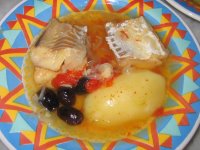First cut the fish into pieces and rinse under water.
In a pan, cook an onion in a small amount of water.
Once the onion is cooked, add the fish, a potato and two tomatoes.
Have the heat on high, and once you see vapours coming out of the pan, turn the heat down to slowly cook the fish.
At the last moment add a few black olives for an extra flavour.
We serve the fish with it’s broth and cut up small pieces of hard bread. It’s delicious!


The terms "dried cod" and "stockfish" express two different ways to treat the same fish, the codfish. The sea waters off Norway, Iceland, the Baltic Sea and Newfoundland are extremely rich of this fish, because the sea waters in these lands are very cold and limpid. During the cold northern winters the fish is dumped on the shore and brought to drain for months on wooden hurdles at a temperature near to 0°C. The fish is then exposed to the cold atmosphere and the feeble sunrays of the Northern skies. As a result you get the "stockfish", whose name derives from the german word "stock", meaning a staff (or cane) which shape and hardness it resembles. In the summer, when the temperature is raised, this method, for obvious reasons due to the deterioration of the codfish flesh, cannot be practiced and the solution is in the salt + barrels method. Once the codfish has been caught, and got rid of its head, fins, tail and interiors already on the fishing boat, it is immediately put into barrels, and generously covered with salt, that guarantees its draining and a long preservation. This is the "dried cod"..





1 comment:
this looks really good, but it would seem like the fish would be way overcooked by the time the potato was done. But apparently not?
Post a Comment